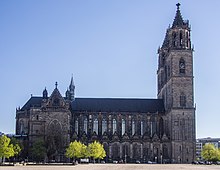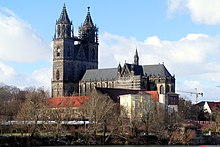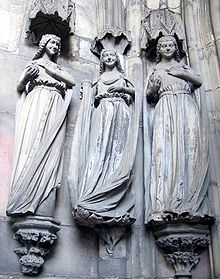Magdeburg Cathedral
The Magdeburg Cathedral, officially Cathedral of Saints Maurice and Catherine (German: Magdeburger Dom; Dom zu Magdeburg St. Mauritius und Katharina), was one of the first Gothic cathedrals in Germany. With a height of its towers of 99.25 and 100.98 m, respectively, it is one of the tallest cathedrals in the former German Democratic Republic. The cathedral is located in the city of Magdeburg, capital of the federal state of Saxony-Anhalt, in Germany, and is also home to the tomb of Otto I of Germany.
The first church built in the year 937 on the location of the current cathedral was the Abbey of Saint Maurice, dedicated to Saint Maurice. The construction work of the current cathedral lasted just over 300 years, from the beginning in 1209 to the completion of the capitals in 1520. Despite having been looted on several occasions, it is rich in art, spanning from the Middle Ages. to contemporary art.
History
Primitive construction


The first church, founded on September 21, 937 in the same location as the current cathedral, was the Abbey of Saint Maurice (St. Moritz), dedicated to Saint Maurice and financed by the Emperor Otto I the Great, who promoted great works that are now included in the so-called Ottonian architecture. Otto wanted to demonstrate his political power after the victory at the Battle of Lechfeld in 955 and ordered the construction even before his coronation as Emperor in 962. Furthermore, to support his candidacy as successor of the emperor of the Western Roman Empire (Weströmisches Reich), obtained a large number of antiquities, such as pillars to be used in the construction of the temple. Many of those antiquities were later used to build the second temple in 1209. It is most likely that the early church had a nave with four side chapels, a width of 41 m and a length of 80 m. The height is estimated to be greater than 60 m.
Otho's wife, Queen Edith, was buried in the temple after her death in 946. The temple was expanded in 955. From that moment on, the temple became a cathedral. In 968, Emperor Otto chose Magdeburg as the seat of an archdiocese, the archbishopric of Magdeburg, with Adalbert of Trier as archbishop, even though the city was not in the center of the kingdom, but on the eastern border. The reasons for this decision must be sought in the intention to expand the kingdom and Christianity to the east, towards what is currently Slovakia. However, this plan could not be carried out, since the emperor died in 973 in the city of Memleben, being buried in the cathedral next to his wife.
St Maurice's Cathedral was completely destroyed during a city fire on Good Friday 1207. Everything except the south wing of the cloister was destroyed by the flames. Archbishop Albrecht II von Kefernburg decided to tear down the remaining walls and build a new cathedral, despite opposition from part of the city's population. Only the south wall of the cloister was respected and even today it continues to be part of the current cathedral. The exact location of the ancient temple was unknown for many years until the foundations were found in May 2003, revealing the measurements of the previous cathedral. The old crypt has been excavated and can be visited by the public.
The square in front of the cathedral, usually called "the new market square" (Neuer Markt), was occupied by an imperial palace that was destroyed by fire in 1207. Stones from the ruins were used to build the cathedral. The alleged remains of the palace were excavated in the 1960s.
Construction of the current building



Because Archbishop Albrecht von Kefernburg had studied in France and Italy, he was aware of the new Gothic architecture that was developing in France, but was still totally unknown in Germany, which led him to build the new cathedral in the new French style. The builders and workers did not know this new style, which was a drawback for its construction, since they had to learn it slowly and progressively. Construction of the choir began in 1209, just two years after the fire that destroyed the first cathedral. Therefore, the choir was still built in Romanesque style, initially using groin vaults combined with Gothic elements.
The influence of Gothic increased especially between 1235 and 1260 under the rule of Archbishop Wilbrand. As construction was overseen by numerous people over the course of three hundred years, numerous changes occurred to the original plan, and the size of the cathedral increased considerably. The inhabitants of Magdeburg were not always happy with these decisions, since they had to pay for the construction. On some occasions, walls or pillars already built were demolished to comply with the wishes of the supervisor in charge at that time.
Construction stopped in 1274. In 1325 Archbishop Burchard III von Schraplau was assassinated by the citizens of Magdeburg because of high taxes. Tradition says that what sparked the anger was the tax on beer. After this the city was punished and the construction of the cathedral could only be resumed after the donation of five altars as atonement. Construction was supervised by Archbishop Otto von Hesse, who was able to complete the interior of the temple and formally open the cathedral in 1363 with week-long celebrations. The cathedral was dedicated not only to Saint Maurice like the previous one, but also to Saint Catherine.
In 1360, the works stopped again after provisionally covering the unfinished parts. In 1477 construction resumed under the supervision of Archbishop Ernst von Sachsen, including the construction of the two towers. The towers were built by the master Bastian Binder, the only master of the cathedral whose name is known. The construction of the cathedral was completed in 1520 with the placement of the ornamental cross on the north tower.
The Protestant Reformation, the Wars of Religion and the Napoleonic invasion


On October 31, 1517, Martin Luther posted his 95 theses on the door of the Wittenberg Castle Church in Germany, which began the Protestant Reformation. Luther preached in Magdeburg in 1524 and this caused numerous churches in the city to convert to Protestantism. The unpopularity of Archbishop Albrecht von Brandenburg contributed to the spread of the new religious current in the city, and after his death in Mainz in 1545 there was no successor to the see. Magdeburg became a leading center of the Reformation, causing Emperor Charles V to declare it outlawed. The Catholic Church decided to keep the cathedral treasures in Aschaffenburg to protect them from possible destruction by the Lutherans. However, the treasure was eventually lost to Swedish troops during the fighting of the Thirty Years' War. The priests of the cathedral also converted to Protestantism and on the first Sunday of Advent in 1567 the first Protestant service was held in the cathedral.
During the Thirty Years' War (1618-1648), the city was attacked and only 4,000 citizens managed to survive the series of murders, rapes and looting to which the city was subjected (Sacking of Magdeburg) thanks to who requested refuge inside the temple. The head pastor, Reinhard Bakes, pleaded for the lives of his faithful to Johann Tserclaes, Count of Tilly. The cathedral survived the fires that the city suffered and was rededicated to Catholic worship. However, after the departure of the Count of Tilly's Catholic troops from Magdeburg, the cathedral was looted and the colorful stained glass windows destroyed. The city of Magdeburg lost 20,000 citizens during the war, which ended with only 400 inhabitants. The city became part of Brandenburg and was transformed into a fortress.
In 1806 Magdeburg fell into the hands of Napoleon and the cathedral was used as a warehouse, horse stable and sheep corral. The French occupation ended in 1814, and between 1826 and 1834 Frederick William III of Prussia financed the much-needed repairs and reconstruction of the cathedral. The stained glass windows were all replaced in 1900.
The 20th century
The cathedral was not damaged during World War I, but frequent Allied bombing during World War II destroyed the stained glass windows again. During the intense bombing of January 16, 1945, a bomb fell on the western part of the cathedral, collapsing a wall and destroying the organ and other parts of the building. Fortunately, the fire brigades managed to control and extinguish the fire before it damaged the roof structures, so the damage suffered was only moderate. The cathedral was reopened in 1955 and in 1969 the new, smaller organ was installed in a different place than before.
When the socialist state of the German Democratic Republic was created in 1949, the city passed into the Soviet sphere of influence. Communist leaders attempted to suppress religion as a threat to the system. However, religion could not be eradicated and starting in 1983 prayers for peace were recited weekly in front of the Magdeburger Ehrenmal, a sculpture by Ernst Barlach. This led to the famous Monday Demonstrations in 1989 in Leipzig and Magdeburg, which played an important role in the subsequent unification of Germany.
In 1983 the government of the G.D.R. Reconstruction work began and already in 1990 a photovoltaic solar energy installation was installed for the first time in a cathedral in East Germany to provide energy to the cathedral itself or even to the general grid. The installed power amounts to 418 watts. In 2004, a fundraising effort that began in 1997 for a new organ ended, having raised two million euros. The construction of the new 36-tonne organ was commissioned by a Potsdam company, and it has 93 registers and approximately 5,000 pipes. According to the planned plan, the organ should have been completed in 2007 and could be used in 2008.
The Magdeburger Ehrenmal is once again the starting point of numerous Monday demonstrations, although this time these demonstrations have the purpose of fighting against the government's social reforms that attempt to reduce social spending. However, these demonstrations are on a much smaller scale if we compare them with those organized in 1989 and tend to have a propaganda nature.
Architecture

The current cathedral was built over a period of about three hundred years, beginning in 1209 and ending with the placement of the spiers or spiers in 1520. Since Gothic architecture had been developed in France during the century XII, there were no previous examples of this type of architecture in Germany, so local craftsmen were not yet familiar with this new style. Therefore, the builders of the cathedral became familiar with and learned the keys to this new style as construction progressed, a fact that can be observed in small architectural changes throughout the entire construction period. Construction began with the presbytery, in the eastern part of the temple, near the Elbe River, and ended with the top of the towers. This sanctuary shows a marked influence of the Romanesque style. Unlike the rest of the Gothic cathedrals, Magdeburg does not have flying buttresses to reinforce the support on the walls.
The cathedral has an interior length of 120 m and a height to the roof of 32 m. However, the two towers reach a height of 99.25 and 100.98 m, making them the tallest church towers in the entire former G.D.R. The cathedral has a central nave and two side naves with a transept. Each side of the transept has an entrance, the one on the south side leading to the cloister. The height to the ceiling in the central nave is greater than in the side naves, allowing the clerestory windows to provide light to the central nave. It has a separate narthex in the western part. The sacristy in the east is separated from the nave by a stone wall, which in turn acts as a separation between the nave and the apse. The apse is in turn surrounded by an ambulatory. A secondary construction around the large non-rectangular cloister is connected to the south side of the cathedral. The cloister, whose south wall survived the fire of 1207 and comes from the original church, is, like the original cloister, parallel to the church that suffered the fire. As the current cathedral was built at a different angle than the original, the cloister maintains a strange angle to it.
In the city of Magdeburg, the land near the Elbe River is soft, making it difficult to build high-rise buildings. For this reason, the cathedral was built on a huge underground rock, the only point on which a building of that height could be built. The rock is known by the German name Domfelsen and is visible when the level of the Elbe River is sufficiently low. In ancient times, a too low river level meant a poor harvest, which is why the rock is also known as Hungerfelsen, which means hunger rock. In any case, the rock was not large enough to be able to build the entire cathedral on it, so at the western end only the north tower could have its foundations on the solid rock, while the south tower remains on the soft ground. To reduce the weight of the south tower, it completely lacks stairs or other components inside. The heavy bells are all housed in the north tower, which can support this increase in weight. However, the south tower is slightly higher than the north and an attempt was made to visually correct this by adding an ornamental cross on the north tower.
Art


Despite the pillage and looting to which it was subjected, Magdeburg Cathedral is rich in artistic representations, covering a wide range of objects and elements ranging from antiquity to contemporary art. Below is a selection of the most notable pieces. The objects are presented approximately in order of age.
- Ancient marble, porphydo and granite pillars used in the apse that originally belonged to buildings of Rávena and were transported to Magdeburg to build the first church in 937.
- The baptismal Pila made of porphydo from somewhere near Aswan (Egypt). Originally used as a source with an orifice in the center. The object has an antiquity of thousands of years and is still used today to provide the sacrament of baptism.
- The tomb of Oton I, emperor of the Holy Roman German Empire from 973. During an exhumation in 1844 it was discovered that the sarcophagus contained a skeleton and some clothes, but everything had been looted, allegedly during the Thirty Years War.
- The sculpture representing San Mauricio, approximately 1250, is the first representation of African ethnicity in Central European art, clearly showing the ethnic characteristics, such as the broad nose. The figure is not kept whole.
- The sculpture of Saint Catherine, also from approximately 1250, was created by the same artist as the sculpture of Saint Mauritius.
- The Royal Couple (Herrscherpaar) in the chapel of sixteen sides (also dated approximately 1250) is a very realistic sculpture with very natural expressions. The identity of the couple is unknown, but it could represent Emperor Oton I and his wife Editha or even Jesus Christ in heaven with his "wife" the Church.
- The sculptures of the five wise virgins and the five foolish (representing the ten virgins who appear in the parable of the Gospel of Matthew), which also date from about 1250. This is the most important piece of art with which the cathedral counts. The five wise virgins are prepared and they bring oil to the wedding, while the fools are not prepared or carry the oil. Therefore, at the time the bride and grooms arrive, they must go find the oil for their lamps and arrive at the banquet when the doors have already been closed. The unknown author of the sculptures masterfully shows the emotions in the faces and along with the body language of the girls, there are much more realistic expressions of what was usual at the time. All figures are different and have Slavic features. The sculptures are located outside the north entrance to the transept.
- The choir seats, which date back to 1363, are masterfully broken and show episodes of Jesus' life. The unknown author is also the author of the choir of the Cathedral of Saint Peter of Bremen.
- The Magdeburger Ehrenmal Ernst Barlach was commissioned as a monument to the heroes fallen in the war, but because of his participation as a volunteer in World War I, Barlach positioned himself against the war, so he showed the suffering and pain of this. This caused great controversy, and the monument was about to be destroyed. The place in front of the sculpture served as a meeting point for the beginning of the Manifestations of Mondays.
- The Lebensbaumkruzifix (literally: Tree of the Cross of Life) is a painted bronze sculpture of 1988 that shows Jesus nailed into a tree instead of on the cross. Jesus is subject to the tree only by his hands and feet. The sculpture was conceived to be contemplated not only from the front, but from all sides of it. The whole tree is shown without life, except in a small leaf that flows from there where the blood of Jesus has dripped. The artist, Professor Jürgen Weber, wanted the sculpture to be placed in a central place near the altar, but against his wishes it was placed on the south side of the transept.
Contenido relacionado
114
77
Jackson Day